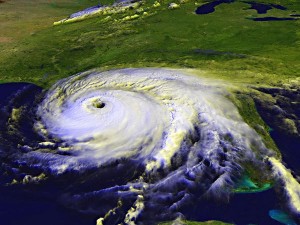When I was little, I thought of Sandy as the pretty, blonde girl in Grease, or the shaggy dog in Annie. But ever since high school, I now associate the name Sandy with the hurricane that destroyed so many of my classmates’ homes. So recently, when I was listening to the news warning of the impending doom of Hurricane Matthew, it made me wonder how hurricanes get their names and why they have names at all.
I learned that the history of naming hurricanes is far more involved than I would have ever imagined. Apparently an Australian forecaster by the name of Clement Wragge was the first person to not only track storms, but to give them names. According to Chris Landsea at the Atlantic Oceanographic and Meteorological Laboratory , it was in the early 1900s when Wragge first started using letters of the alphabet to name the storms. It was when the government of Australia refused to support his efforts, that he began naming the storms after local politicians that he did not like.
In the United States, the naming of storms seems to have begun with military forecasters. Most often they named them by using the alphabet, but there were occasions when female names seemed to sneak into use. But why name these storms at all? The true need for the names arose in the early 1950s. During the summer months there were several storms brewing at the same time. This caused major confusion during radio broadcasts when people were not sure which warnings applied to which storm. So , in 1950, the United States Weather Bureau and the Interdepartmental Hurricane Conference named the fourth storm of the year, Fox. In 1953, the Weather Bureau and the Hurricane Conference officially began using female names to label the storms. Of course, only using female names led to some controversy. As more women became meteorologists and as women’s roles in general began to change, there was a push to include men’s names as well. In the 1970s, Roxcy Bolton, the vice president of the National Organization for Women, petitioned the Weather Service and requested that the storms be named after congressmen and senators. Although her requests were denied for many years, by 1979, Dr. Bob White, the administrator of the National Oceanographic and Atmospheric Administration admitted that it was the right thing to include men’s names on the list.
Today, tropical storms are given a name when they develop a rotating pattern and wind speeds of 39 MPH. At 74 MPH , they become hurricanes. There are six lists of hurricane names in use for the Atlantic Ocean. The lists rotate, with one being used each year. This year’s list, for example, will be used again in six years. The one exception to that rule, however, is that the names of particularly deadly or damaging storms are taken out of the rotation. Camille, Katrina, and Sandy, for example, will no longer be used. A complete list of retired names can be found at the National Weather Service website.
This year’s Atlantic hurricane names include: Alex, Bonnie, Colin, Danielle, Earl, Fiona, Gaston, Hermine, Ian, Julia, Karl, Lisa, Matthew, Nicole, Otto, Paula, Richard, Shary, Tobias, Virginie, and Walter. I would guess that because of Matthew’s strength and devastation, it will now be taken out of the rotation . So maybe someday soon I will be able to return to the days of thinking of Sandy as a dog.
Link of photo : https://goo.gl/images/IblYya


I’m from Miami, so I’m pretty familiar with hurricanes and I could probably recite all the hurricanes that I watched through my window as a kid. I used to wonder the same thing- why did the hurricanes have the same names as me and my friends? My dad’s home was destroyed by Hurricane Andrew, and so he and his brothers always used to say poor things about “a guy named andrew” and I never realized he meant the hurricane until I was about 10. https://en.wikipedia.org/wiki/Effects_of_Hurricane_Andrew_in_Florida this link describes the effects of the storm on houses like his in south florida
Samantha,
I thoroughly enjoyed your blog about the naming of hurricanes. I grew up in South Florida, Miami to be exact and hurricanes are a major part of South Florida weather. Many of my family and friends were forced to evacuate their homes because of the brute strength of Hurricane Matthew. I have witnessed and been through many hurricanes while living in Miami. Fortunately, there has been a major down turn in the amount of hurricanes that have hit South Florida. The last major hurricane I can think of was Hurricane Wilma and that was probably around ten years ago. Because of Wilma’s strength, it was in fact taken out of the rotation that you mentioned in your blog. Miami has the highest probability of being hit by a hurricane. To learn why and see other cities that are vulnerable to hurricanes, check this out.